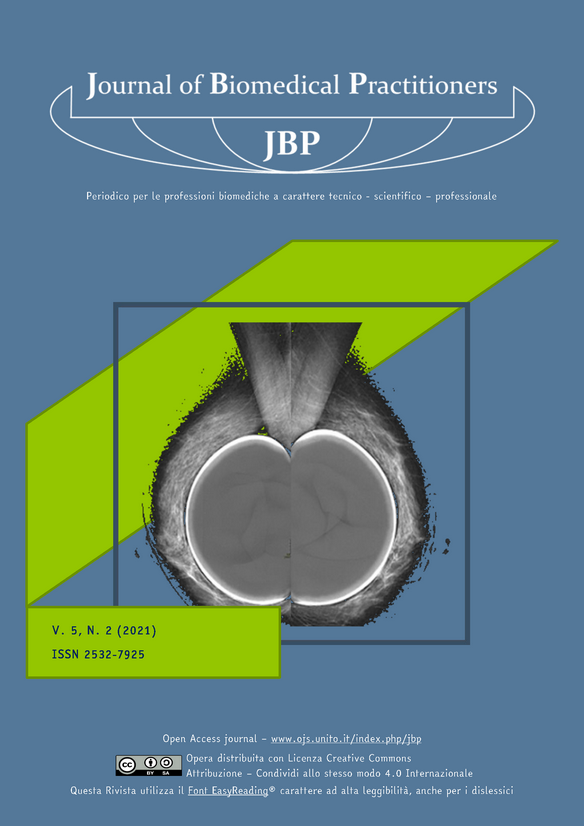Open Science and Open Access Scientific Publishing: an essential combination. An analysis of the first 4 years of JBP activity
Contenuto principale dell'articolo
Abstract
In July 2017, the Journal of Biomedical Practitioner (JBP) starts publications with its first number. Since its debut JBP would offer itself as a meeting place to health professionals, free to all and Open Access, without prejudices for experience exchanging between people that work in Biomedical Sciences with various purposes from welfare, diagnostic-therapeutic, rehabilitation and prevention, to the fields of basic and clinical research.
JBP it’s a six-monthly publication, with double-blind peer review, written in Italian and English language.
This editorial aims to analyze in deep the journal path in these 4 years, reporting the poster contents shown at 2° Congresso Nazionale della Federazione Nazionale Ordini dei Tecnici Sanitari Radiologia Medica e delle Professioni Sanitarie Tecniche, della Riabilitazione e della Prevenzione (FNO TSRM e PSTRP) that took place in Rimini on 19-21 november 2021.
The improvement of quality standards offered will be highlighted, noting the fundamental role of the contribution of the auditors. The metadata analysis on the OJS/PKP platform, which is used by the journal and in turn it’s hosted by Sistema di Riviste Open Access (SIRIO@Unito) of the University of Turin, shows much interesting information about the article submitted: we received 90 article proposals and the 57% was published, of which the 16% was written in the two languages. The mean time needed was 62 days for the revision process and 110 days to get the article published. In each year were published a mean of 13 papers and 60% of them were written by authors from different professional areas.
The fast access to the contents and the indexing of JPB on the main directories of Open Access Journals are the best reasons to choose this journal for publishing in the Biomedical Science areas.
Downloads
Dettagli dell'articolo
Gli autori mantengono i diritti sulla loro opera e cedono alla rivista il diritto di prima pubblicazione dell'opera, contemporaneamente licenziata sotto una Licenza Creative Commons - Attribuzione che permette ad altri di condividere l'opera indicando la paternità intellettuale e la prima pubblicazione su questa rivista.
Riferimenti bibliografici
[2] Giglia E, Open Access e Open Science: per una scienza più efficace, JBP.2017;1(1):7-28 https://doi.org/10.13135/2532-7925/2299
[3] UNESCO, United Nations Educational, Scientific and Cultural Organization. Towards a UNESCO Recommendationon Open Science 2021. https://en.unesco.org/sites/default/files/open_science_brochure_en.pdf
[4] Bethesda Statement on Open Access Publishing. Released June 20, 2003http://legacy.earlham.edu/~peters/fos/bethesda.htm
[5] Callaway E. Will the pandemic permanently alter scientific publishing? Nature. 2020 Jun; 582(7811):167-168. doi: 10.1038/d41586-020-01520-4. PMID: 32504015.
[6] Roorick, J Open Access lessons during Covid-19: No lockdown for research results!, PlanS blog, June 8, 2020https://www.coalition-s.org/blog/open-access-lessons-during-covid-19-no-lockdownfor-research-results/
[7] Independent Group of Scientists appointed by the Secretary-General. (2019). Global sustainable development re-port 2019: the future is now–science for achieving sustainable development.
[8] https://sustainabledevelopment.un.org/content/documents/24797GSDR_report_2019.pdf
[9] Laura, B., Francesca, B., Migliore, S., Tommaso, P., Cristina, P., Stefania, P., & Maria, S. (2020). Raccomanda-zionedell’UNESCOsullerisorse educative aperte. Traduzioneitaliana a cura del Gruppo di Studio AIB sulla Infor-mation Literacy.
[10] https://www.aib.it/attivita/2020/87617-raccomandazione_unesco_oer/
[11] Organizzazione per la Cooperazione e lo SviluppoEconomico. OECD(2006). Recommendation of the Council con-cerning Access to Research Data from Public Funding.https://www.oecd.org/sti/recommendation-access-to-research-data-from-public-funding.htm
[12] UNESCO, WHO and the UN High Commissioner for Human Rights call for “Open Sci-ence”27/10/2020https://en.unesco.org/news/unesco-who-and-high-commissioner-human-rights-call-open-science
[13] Arrizabalaga O, Otaegui D, Vergara I, Arrizabalaga J, Méndez E. Open Access of COVID19-related publications in the first quarter of 2020: a preliminary study based in PubMed. F1000Res. 2020 Jun26;9:649. doi:10.12688/f1000research.24136.2. PMID: 32850121; PMCID: PMC7438966.
[14] The directory of Open Access journals. Find Open Access journals & articles. https://doaj.org/
[15] Camoni, L., Cossandi, M., & Rinaldi, R. (2020). Come scrivere un articolo originale - o una tesi sperimentale - nell’ambito della ricerca scientifica. Journal of Biomedical Practitioners, 4(2). https://doi.org/10.13135/2532-7925/5459
[16] Casu, C. (2020). Come scrivere un Case Report nell’ambito medico - sanitario. Journal of Biomedical Practitio-ners, 4(2). https://doi.org/10.13135/2532-7925/5460
[17] Stura, I., Alemanni, A., & Migliaretti, G. (2020). Guida pratica alla stesura di una metanalisi clinica. Journal of Biomedical Practitioners, 4(2). https://doi.org/10.13135/2532-7925/5462
[18] Toroser D, Carlson J, Robinson M, Gegner J, Girard V, Smette L, Nilsen J, O'Kelly J. Factors impacting time to acceptance and publication for peer-reviewed publications. Curr Med Res Opin. 2017Jul;33(7):1183-1189.doi: 10.1080/03007995.2016.1271778.Epub 2016 Dec 31. PMID: 27977312.
[19] Ross-Hellauer T. What is open peer review? A systematic review. F1000Res. 2017 Apr 27;6:588. doi: 10.12688/f1000research.11369.2. PMID: 28580134; PMCID: PMC5437951.

